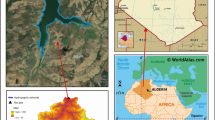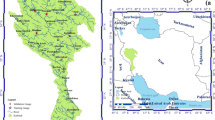Abstract
The challenge of managing sustainable water supply is growing more complex as a result of global climate change. The utilization of dams and reservoirs is essential for effective water resource management. These systems are of utmost importance in the storage and utilization of water throughout the entire year. In water resource planning for these systems, a significant emphasis is placed on predicting inflow to dams. In recent years, there has been notable advancement in artificial intelligence approaches, which have the potential to decrease prediction uncertainties. This study conducts a comparison between implementing machine learning models, specifically the group method of data handling (GMDH), random forest (RF), and adaptive neuro-fuzzy inference system (ANFIS), and the probabilistic Bayesian network method as well as long short-term memory networks (LSTM). This study presents a novel comparison between two black box approaches, analyzing probabilities across three different time scales: monthly, seasonal, and annual. Three temporal approaches were employed to estimate the inflow rate to Zayanderud dam, considering 10 scenarios and identifying influential variables. The results obtained from the simulation showed that the GMDH method, a complex neural network technique, exhibited superior performance in all three temporal scales: monthly, seasonal, and annual. The obtained results were evaluated through the utilization of four statistical indicators. The NS coefficient for the annual approach is 0.98, for the seasonal approach is 0.93, and for the monthly approach is 0.95. Additionally, the mean squared error (MSE) was 0.07, 0.09, and 0.11 for the annual, seasonal, and monthly approaches, respectively. The results showed that the transfer inflow from the Koohrang tunnels and Cheshmeh Langan tunnel greatly influenced the predictions in all three approaches. Furthermore, the precipitation parameter (R) displayed sensitivity solely in the annual and monthly assessments, while no correlation was evident in the seasonal approach.









Similar content being viewed by others
References
Abbasi A, Delavar M, Morid S (2018) Application of hybrid gamma-SVM approach for river flow prediction in Zarinehrud basin. Environ Water Eng 3(4):353–366
Abrishamchi A, Jamali S, Mariño MA, Tajrishy M (2006) Stream flow forecasting and reservoir operation models using fuzzy inference systems. In: Operating reservoirs in changing conditions - proceedings of the operations management 2006 conference, pp 373–382. https://doi.org/10.1061/40875(212)37
Anbari MJ, Tabesh M, Roozbahani A (2017) Risk assessment model to prioritize sewer pipes inspection in wastewater collection networks. J Environ Manag 190:91–101. https://doi.org/10.1016/j.jenvman.2016.12.052
Antanasijević D, Antanasijević J, Pocajt V, Ušćumlić G (2016) A GMDH-type neural network with multi-filter feature selection for the prediction of transition temperatures of bent-core liquid crystals. RSC Adv 6(102):99676–99684. https://doi.org/10.1039/C6RA15056J
Arikan BB, Jiechen L, Sabbah IID, Ewees A, Homsi R, Sulaiman SO (2021) Dew point time series forecasting at the North Dakota. Knowl Based Eng Sci 2(2):24–34
Bhattarai A, Qadir D, Sunusi AM, Getachew B, Mallah AR (2023) Dynamic sliding window-based long short-term memory model development for pan evaporation forecasting. Knowl Based Eng Sci 4(1):37–54
Donahue J, Anne Hendricks L, Guadarrama S, Rohrbach M, Venugopalan S, Saenko K, Darrell T (2015) Long-term recurrent convolutional networks for visual recognition and description, pp 2625–2634.
Fayer G, Lima L, Miranda F, Santos J, Campos R, Bignoto V, Andrade M, Moraes M, Ribeiro C, Capriles P (2023) A temporal fusion transformer deep learning model for long-term streamflow forecasting: a case study in the funil reservoir, Southeast Brazil. Knowl Based Eng Sci 4(2):73–88
Guo L, Chehata N, Mallet C, Boukir S (2011) Relevance of airborne lidar and multispectral image data for urban scene classification using random forests. ISPRS J Photogramm Remote Sens 66(1):56–66. https://doi.org/10.1016/J.ISPRSJPRS.2010.08.007
Han H, Kim D, Wang W, Kim HS (2023) Dam inflow prediction using large-scale climate variability and deep learning approach: a case study in South Korea. Water Supply 23(2):934–947. https://doi.org/10.2166/WS.2023.012
Hong J, Lee S, Bae JH, Lee J, Park WJ, Lee D, Kim J, Lim KJ (2020) Development and evaluation of the combined machine learning models for the prediction of dam inflow. Water 12(10):2927. https://doi.org/10.3390/W12102927
Ibrahim KSMH, Huang YF, Ahmed AN, Koo CH, El-Shafie A (2023) Forecasting multi-step-ahead reservoir monthly and daily inflow using machine learning models based on different scenarios. Appl Intell 53(9):10893–10916. https://doi.org/10.1007/S10489-022-04029-7/METRICS
Jang JSR (1993) ANFIS: adaptive-network-based fuzzy inference system. IEEE Trans Syst Man Cybern 23(3):665–685. https://doi.org/10.1109/21.256541
Kardan Moghaddam H, Rahimzadeh Kivi Z, Bahreinimotlagh M, Moghddam HK (2021) Evaluation of the groundwater resources vulnerability index using nitrate concentration prediction approach. Geocarto Int 37(6):1664–1680. https://doi.org/10.1080/10106049.2020.1797184
Khalilian S, Sarai Tabrizi M, Babazadeh H, Saremi A (2021) Assessing the impact of climate change on the inflow on Zayandehrood Dam. JWSS Isfahan Univ Technol 24(4):255–271. https://doi.org/10.47176/JWSS.24.4.7492
Latif SD, Ahmed AN (2023) Streamflow prediction utilizing deep learning and machine learning algorithms for sustainable water supply management. Water Resour Manag 37(8):3227–3241. https://doi.org/10.1007/S11269-023-03499-9/METRICS
Moghaddam HK, Moghaddam HK, Kivi ZR, Bahreinimotlagh M, Alizadeh MJ (2019) Developing comparative mathematic models, BN and ANN for forecasting of groundwater levels. Groundw Sustain Dev 9:100237
Moghaddam HK, Milan SG, Kayhomayoon Z, Azar NA (2021) The prediction of aquifer groundwater level based on spatial clustering approach using machine learning. Environ Monit Assess 193(4):1–20
Nasiri-Gheidari O, Marofi S, Adabi F (2018) A robust multi-objective bargaining methodology for inter-basin water resource allocation: a case study. Environ Sci Pollut Res 25(3):2726–2737. https://doi.org/10.1007/S11356-017-0527-8/METRICS
Noorbeh P, Roozbahani A, Kardan Moghaddam H (2018) Prediction of zayandeh rood dam inflow and hydrological wet and dry periods using bayesian networks. Water Soil 32(3):633–646. https://doi.org/10.22067/JSW.V32I3.72084
Noori R, Karbassi AR, Moghaddamnia A, Han D, Zokaei-Ashtiani MH, Farokhnia A, Gousheh MG (2011) Assessment of input variables determination on the SVM model performance using PCA, gamma test, and forward selection techniques for monthly stream flow prediction. J Hydrol 401(3–4):177–189. https://doi.org/10.1016/j.jhydrol.2011.02.021
Roozbahani A, Ebrahimi E, Banihabib ME (2018) A framework for ground water management based on Bayesian network and MCDM techniques. Water Resour Manag 32(15):4985–5005. https://doi.org/10.1007/S11269-018-2118-Y/METRICS
Shen X, Wu X, Xie X, Wei C, Li L, Zhang J (2021) Synergetic theory-based water resource allocation model. Water Resour Manag 35(7):2053–2078. https://doi.org/10.1007/S11269-021-02766-X/METRICS
Skariah M, Suriyakala CD (2022) Forecasting reservoir inflow combining exponential smoothing, ARIMA, and LSTM models. Arab J Geosci 15(14):1–11. https://doi.org/10.1007/S12517-022-10564-X
Yousefi M, Wang J, Fandrem Høivik Ø, Rajasekharan J, Hubert Wierling A, Farahmand H, Arghandeh R (2023) Short-term inflow forecasting in a dam-regulated river in Southwest Norway using causal variational mode decomposition. Sci Rep 13(1):1–16. https://doi.org/10.1038/s41598-023-34133-8
Author information
Authors and Affiliations
Corresponding author
Ethics declarations
Conflict of interest
The authors declare that they have no competing interests.
Additional information
Edited by Dr. Khabat Khosravi (ASSOCIATE EDITOR) / Prof. Jochen Aberle (CO-EDITOR-IN-CHIEF).
Rights and permissions
Springer Nature or its licensor (e.g. a society or other partner) holds exclusive rights to this article under a publishing agreement with the author(s) or other rightsholder(s); author self-archiving of the accepted manuscript version of this article is solely governed by the terms of such publishing agreement and applicable law.
About this article
Cite this article
Akbari Osmavandani, S., Sharafati, A. & Moghaddam, H.K. Assessing the effectiveness of artificial intelligence models in predicting Zayanderud dam inflow at different time scales. Acta Geophys. (2023). https://doi.org/10.1007/s11600-023-01257-4
Received:
Accepted:
Published:
DOI: https://doi.org/10.1007/s11600-023-01257-4




